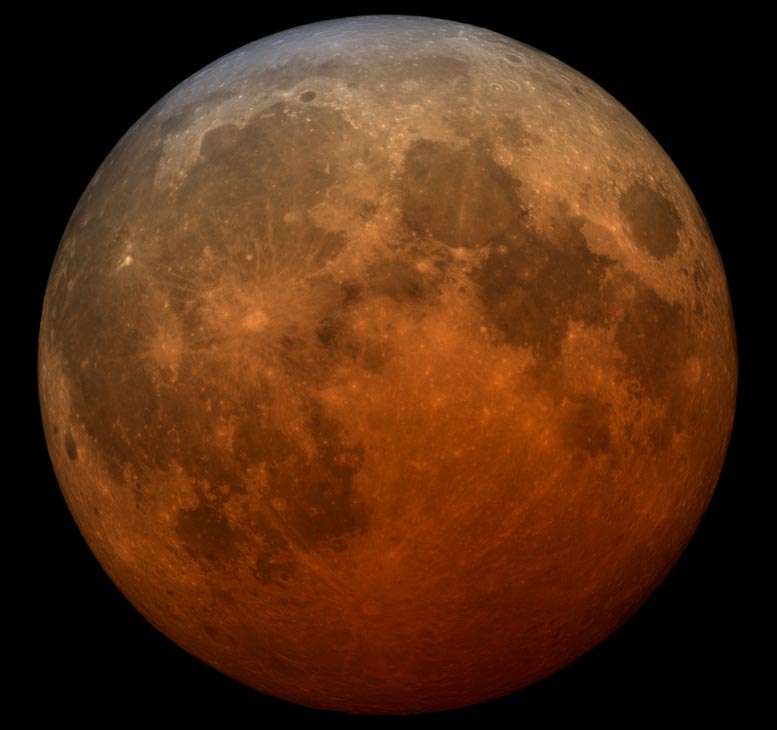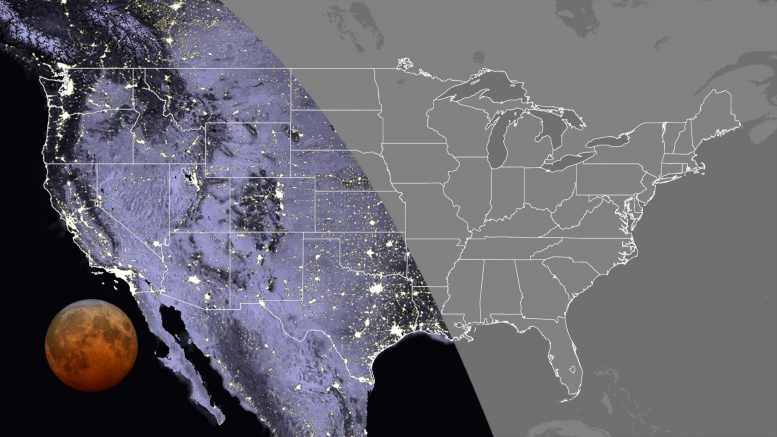
Posted on 05/24/2021 8:31:58 AM PDT by Red Badger

The total lunar eclipse of May 26, 2021 is the first in nearly two and a half years. It occurs within hours of the closest perigee of the year, making the Moon appear about 7% larger than average. The total phase will be visible near moonset in the western United States and Canada, all of Mexico, most of Central America and Equador, western Peru, and southern Chile and Argentina. Totality occurs just after moonrise along the Asian Pacific Rim. The eclipse can be seen in its entirety in eastern Australia, New Zealand, and the Pacific Islands, including Hawaii.
Time Wednesday, May 26, 2021, 11:18:40 UTC
Eclipse 100.0%
Diameter 2005.0 arcseconds
Distance 357463 km (28.02 Earth diameters)
J2000 Right Ascension, Declination 16h 13m 23s, 20° 41′ 04″S
Sublunar Latitude, Longitude 20.737°S 170.252°W
The sublunar point, the last line of the table above, is the point on the Earth’s surface where the Moon is directly overhead. It’s also the center of the hemisphere of the Earth where the eclipse is visible. The closer you are to that location, the higher the Moon will be in your sky. The eclipse percentage in the table is the fraction of the Moon covered by the Earth’s umbra, the part of its shadow in which the Sun is completely blocked. The part of the shadow in which the Sun is only partially blocked is called the penumbra.
The two animations above run from 8:30:00 to 13:59:50 UTC. The exposure setting of the virtual camera changes around totality in order to capture the wide dynamic range of the eclipse. The parts of the Moon outside the umbra during the partial phases are almost as bright as an ordinary full moon, making the obstructed parts appear nearly black. But during totality, our eyes adjust and reveal a range of hues painted on the Moon by all of Earth’s sunrises and sunsets.
All phases of a lunar eclipse are safe to view, both with your naked eye and an unfiltered telescope.
On May 26, 2021, during early morning in the western Americas, the Moon enters the Earth’s shadow, creating a total lunar eclipse, the first in almost two and a half years. This animation shows the region of the Earth where this eclipse is visible. This region shifts to the west during the eclipse. Observers near the edge of the visibility region may see only part of the eclipse because for them, the Moon sets (on the eastern or right-hand edge) or rises (on the western or left-hand edge) while the eclipse is happening.
Contour lines mark the edge of the visibility region at the contact times. These are the times when the Moon enters or leaves the umbra (the part of the Earth’s shadow where the Sun is completely hidden) and penumbra (the part where the Sun is only partially blocked). For observers located on a contour line, the contact occurs at moonrise (west) or moonset (east).

Visibility of the total phase in the contiguous U.S., at 11:11 UTC. Totality can be seen everywhere in the Pacific and Mountain time zones, along with Texas, Oklahoma, western Kansas, Hawaii and Alaska. Credit: NASA’s Scientific Visualization Studio
On May 26, 2021, during early morning in the western Americas, the Moon enters the Earth’s shadow, creating a total lunar eclipse, the first in almost two and a half years. The animation below shows the changing appearance of the Moon as it travels into and out of the Earth’s shadow, along with times at various stages. Versions of the animation have been created for both Universal Time (UTC) and Pacific Daylight Time (PDT) — within the U.S. Lower 48, those in the Pacific time zone are best situated to see the eclipse.
The penumbra is the part of the Earth’s shadow where the Sun is only partially covered by the Earth. The umbra is where the Sun is completely hidden. The Moon’s appearance isn’t affected much by the penumbra. The real action begins when the Moon starts to disappear as it enters the umbra at about 2:45 a.m. Pacific Daylight Time. An hour and a half later, entirely within the umbra, the Moon is a ghostly copper color. For this relatively shallow eclipse, totality lasts only 15 minutes before the Moon begins to emerge from the central shadow.
The view in these animations is geocentric. Because of parallax, the Moon’s position against the background stars will look a bit different for observers at different locations on the surface of the Earth. The Moon is in the constellation Scorpius. The two bright stars in the upper right are ω1 and ω2 Scorpii.
Ping!................
All these weird pagan and indian names for full moons in recent years. It gets annoying and has no astronomical meaning.
I don’t know what UTC time is. When does this occur in Central time?
I see a Bad Moon arising....................
I don’t know about pagan names, but, the Blood Moon is mentioned in the Bible.
That being said, I would much prefer that organizations that present themselves at Science based, would stick to science based.
When I was a kid they were all cheese moons.
Acts 2—Day of Penecost:
These people are not drunk, as you suppose. It’s only nine in the morning! 16 No, this is what was spoken by the prophet Joel:
17 “‘In the last days, God says,
I will pour out my Spirit on all people.
Your sons and daughters will prophesy,
your young men will see visions,
your old men will dream dreams.
18 Even on my servants, both men and women,
I will pour out my Spirit in those days,
and they will prophesy.
19 I will show wonders in the heavens above
and signs on the earth below,
blood and fire and billows of smoke.
20 The sun will be turned to darkness
and the moon to blood
before the coming of the great and glorious day of the Lord.
21 And everyone who calls on the name of the Lord will be saved.
UTC is basically “London time”.

Just outside the viewing zone here in MO
Oh well. Saw one not too many years ago
The Super Duper Monster Chiller Horror Red Blood Werewolf Mega-Moon.
Is trouble on the way? No - it is already here - the POTUS and Congress.
UTC = Universal Coordinated Time (aka Geenwich Mean Time) in Greenwich England.
Subtract -5 hours from UTC to calculate CDT.
https://www.worldtimebuddy.com/
Correction:
UTC = “Coordinated Universal Time” (aka Geenwich Mean Time) in Greenwich England.
Subtract -5 hours from UTC to calculate CDT.
https://www.worldtimebuddy.com/
On the Orthodox Feast of Mid-Pentecost...also Pentecost Wednesday (or Wednesday in the Octave of Pentecost) in the Western church!
Disclaimer: Opinions posted on Free Republic are those of the individual posters and do not necessarily represent the opinion of Free Republic or its management. All materials posted herein are protected by copyright law and the exemption for fair use of copyrighted works.